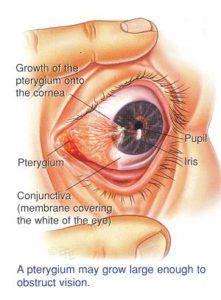A pterygium is a common sun-induced growth affecting both the white of your eye (the sclera) and covering over the coloured part of your eye (the cornea). A pingueculum is typically a more yellow-coloured growth that is also caused by sun exposure.

Image Source: RANZCO
Pterygiums and pinguecula can cause several problems including:
- A gritty / sore eye
- Blurred vision
- Constantly red eye
- A change in your glasses prescription
- Interference with contact lenses
Surgical removal of the pterygium / pingueculum is usually a fairly straightforward operation performed with local anaesthetic and sedation from an anaesthetist. It is performed as day surgery, so patients can return home soon after the surgery is finished. The surgery usually takes around 25 minutes to perform. Firstly, your surgeon will remove the pterygium/pingueculum. They will then cover this site with some of your own conjunctiva (the clear membrane covering the white of your eye) taken from the top part of your eye under your upper eyelid. This is referred to as a ‘conjunctival autograft’. Using a conjunctival autograft has been demonstrated to significantly reduce the risk of the pterygium regrowing to around 1 in 300 or even less.
After the operation the eye is generally sore and gritty, and can even be painful, for the first few days. Most people are able to return to work within a week following the operation. The area from where the pterygium was removed is red and swollen for several weeks following the surgery. It takes 2 to 3 months for the last bit of redness to disappear. After the surgery has healed the area where the pterygium was removed from usually appears cosmetically normal.


